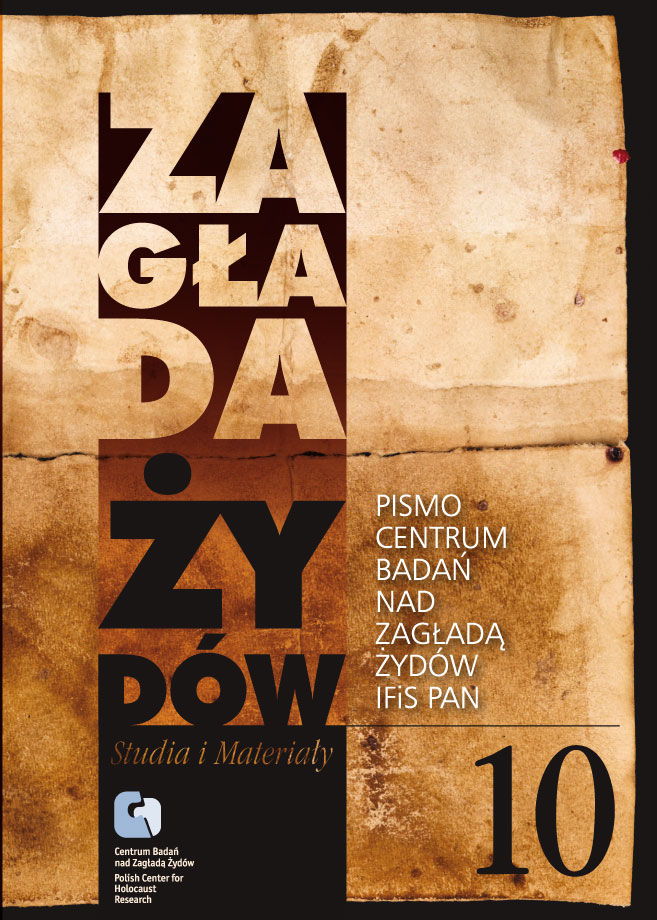Krzesiny i Kreising – między pamiętaniem a pomijaniem. Polskie miasteczko wobec historii, pamięci i rywalizacji w cierpieniu
Zagłada Żydów. Studia i Materiały, Nr 10 (2014), Strony: 443-461
Data zgłoszenia: 2020-10-22Data publikacji: 2014-12-01
 https://doi.org/10.32927/ZZSiM.532
https://doi.org/10.32927/ZZSiM.532
Abstrakt
The area around Krzesiny, located near the city of Poznań, Poland, witnessed several dark events during World War II: Germans oppressed the local population, culminating in a terrorizing action dubbed “akcja krzesińska;” also, a forced labor camp, named “Kreising,” was built near the township, housing mainly Jews. After the war, the suffering in Krzesiny was remembered, but selectively – “akcja” and other forms of Polish suffering were commemorated, while the camp was not. By exploring the “lieux de mémoire” in Krzesiny – dynamics of memory in a small township in Poland – this paper uses localized research to address the issue of gaps in collective memory and commemoration. We briefly look at the relevant history, Polish memory regarding wartime events in Krzesiny, and the postwar dynamics of collective memory. Discussing the latter, we identify a new phenomenon at work, one which we dub “collective disregard” – group neglect of the past of the “Other” that occurs without clear intent. We argue that “collective disregard” is an issue that naturally occurs in the dynamics of memory. By making a deliberate investment in balanced remembrance and commemoration, societies can counter the tendencies of “disregard” and curb the controversies of competitive victimization claims, also called “competitive martyrdom”.
Licencja
Prawa autorskie (c) 2014 Autor & "Zagłada Żydów. Studia i Materiały"

Utwór dostępny jest na licencji Creative Commons Uznanie autorstwa 4.0 Międzynarodowe.
https://creativecommons.org/licenses/by/4.0
Podobne artykuły
- Sławomir Buryła, Jean Améry, Poza winą i karą. Próby przełamania podjęte przez złamanego , Zagłada Żydów. Studia i Materiały: Nr 3 (2007)
- Anna Zawadzka, Piotr Forecki, Reguła złotego środka. Kilka uwag na temat współczesnego dominującego dyskursu o „stosunkach polsko-żydowskich” , Zagłada Żydów. Studia i Materiały: Nr 11 (2015)
- Anna Wylegała, Recenzja: John-Paul Himka, Ukrainian Nationalists and the Holocaust: OUN and UPA’s Participation in the Destruction of Ukrainian Jewry, 1941–1944, seria „Ukrainian Voices”, t. 12, Stuttgart: ibidem, 2021, 540 s. , Zagłada Żydów. Studia i Materiały: Nr 18 (2022)
- Roman Romantsov, Od radzieckiej amnezji do ukraińskiej (nie)pamięci. Zagłada w pamięci kulturowej Ukrainy 1991–2017 , Zagłada Żydów. Studia i Materiały: Nr 14 (2018)
- Tomasz Ceran, Peter Longerich, Himmler. Buchalter śmierci , Zagłada Żydów. Studia i Materiały: Nr 11 (2015)
- Justyna Kowalska-Leder, Literatura polska ostatniego dziesięciolecia wobec Zagłady – próby odpowiedzi na nowe wzywania , Zagłada Żydów. Studia i Materiały: Nr 10 (2014)
- Martyna Grądzka-Rejak, Jan Olaszek, Postawy i zachowania Polaków wobec Żydów w czasie okupacji niemieckiej w publikacjach drugiego obiegu w PRL , Zagłada Żydów. Studia i Materiały: Nr 15 (2019)
- Justyna Kowalska-Leder, Wszechobecność Sprawiedliwych , Zagłada Żydów. Studia i Materiały: Nr 10 (2014)
- Robert Szuchta, Piotr Trojański, Jak pisać podręczniki szkolne o Zagładzie? Na marginesie recenzji książki pt. Zrozumieć Holokaust , Zagłada Żydów. Studia i Materiały: Nr 9 (2013)
- Piotr Forecki, Anna Zawadzka, The Golden Mean Principle. A Handful of Comments on the Currently Dominant Discourse on ‘Polish-Jewish Relations’ , Zagłada Żydów. Studia i Materiały: Nr Holocaust Studies and Materials (2017)
<< < 1 2 3 4 5 6 7 8 9 10 11 12 13 14 15 16 17 18 19 20 21 22 23 24 25 26 27 28 29 30 31 32 > >>
Możesz również Rozpocznij zaawansowane wyszukiwanie podobieństw dla tego artykułu.
 English
English
 Język Polski
Język Polski








